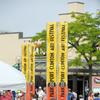Sculptor's Awe of the Animal Kingdom Highlighted in 'Modern Menagerie' Exhibition
- SACRAMENTO, California
- /
- December 10, 2018
The Crocker Art Museum, in Sacramento, Calif., has opened "Modern Menagerie", an exhibition of sculptures by Loet Vanderveen, a California artist originally from the Netherlands. Vanderveen (1921–2015) became internationally recognized for his remarkable ability to capture animals' subtle expressions and gestures with minimal detail.
The exhibition, through March 31, 2019, primarily features works from the Crocker's permanent collection.
"Loet Vanderveen was a great friend to the Crocker. He gifted the Museum with his personal art collection as well as many of his own sculptures," says the Museum's Director and CEO, Lial Jones. "We are delighted to show his works together in this exhibition, and present the community with this opportunity to appreciate his minimalist aesthetic, as well as connect with his personal narrative and his lifelong fascination with the animal kingdom."
Loet Vanderveen was born in Rotterdam, The Netherlands. As a boy, he frequently visited the zoo located near his home, and the zoo staff came to know him by name and by face. Recognizing his growing fondness for animals, the staff allowed Vanderveen to assist in caring for primates and to help raise a lion cub. Vanderveen's was heartbroken when the lion grew large enough to be placed in a cage. His growing bond with the animals led to dreams of traveling abroad — especially to Africa — to see the creatures in their natural habitats.
The German invasion of Rotterdam during World War II brought an abrupt end to Vanderveen’s zoo visits. He was devastated when, in preparation for an air raid in 1940, the Dutch army killed many of the zoo's animals in an attempt to minimize further chaos.
“I got there right after the bombardment, and the whole place was in ruins,” Vanderveen later recalled in an article published by The Artifacts Gallery. "The lions and big cats — many of them were shot. But in the midst of it all, there was one elephant roaming. It was very, very poetic.”
With the German occupation of Rotterdam, Vanderveen, of Jewish descent, came to witness and experience human suffering. He escaped the Nazi-occupied territory and was briefly held captive in France.
After the war, Vanderveen took up residence in New York where he pursued his interests in fashion design. During this time, Vanderveen met Fong Chow, an accomplished ceramist and a curator at the Metropolitan Museum of Art. Inspired by Chow, Vanderveen became fascinated with clay and the complex art of glazing. He abandoned the fashion industry and took private lessons from Chow for three years. The knowledge Vanderveen acquired would later inform his experiments with bronze patinas.
In 1959, Vanderveen settled along the coast of Big Sur, California. His home and studio offered respite from the city and gave him the opportunity to focus on his ceramics. He soon transitioned from vessels to humorous human figures that captured the nuances of human interaction — qualities that he adapted as he began to explore animal figures, which would become the primary subject of his work.
In 1985, Vanderveen’s residence was lost to a wildfire in Monterey County that scorched more than 50,00 acres. Undeterred by the loss, he rebuilt his home and studio and continued working daily on his bronze sculptures. Upon is death at the age of 93, many of his works were brought to their new home at the Crocker Art Museum, where they are preserved for future generations to appreciate.
"Modern Menagerie: Sculpture by Loet Vanderveen" is an exhibition of 33 bronze, marble, and ceramic sculptures, most of which feature animals grazing, moving in herds, and stalking their prey. The exhibition also features several examples of the artist's early ceramic works, including two vessels.
Crocker Art Museum Assistant Curator Christie Hajela notes that many of Vanderveen's sculptures resemble objects that the artist collected during his travels to Africa, Asia, Central America, and other countries and cultures around the world.
“Vanderveen’s animal sculptures have a timeless quality, which is part of what gives them their broad appeal," says Hajela. "Their streamlined surfaces and minimal details resonate with a modernist aesthetic, while they also clearly echo some of the ancient objects in his collection. The similarities between the artist’s own Royal Horse and the ancient Chinese ceramics he gifted to the Crocker, for instance, are unmistakable.”
This exhibition is organized by the Crocker Art Museum. A full-color, hard copy catalogue accompanies the exhibition and is available at the Crocker Art Museum Store.














100x100_c.jpg)

